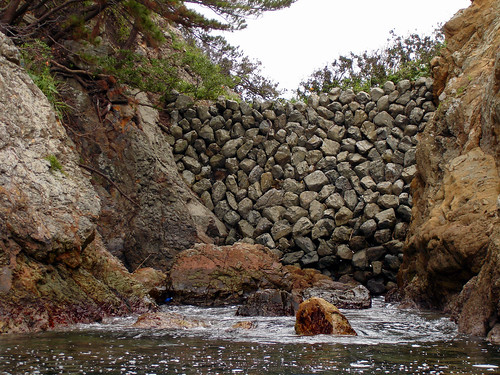seawall
We now turned west, and in the distance spotted a tall smokestack in Saiki, belching large quantities of smoke; this became our beacon. On one of the several promontories we passed on the way, a stone wall had been built to keep the sea from breaking through and damaging some fish farms on the other side of a narrow isthmus. No concrete had been used, and the wall surely sees some action from time to time, with the ocean lapping at its base. Yet the stacked stones stubbornly continue holding their place.
We arrived at Saiki at 4pm, where in the industrial Banjo River estuary dozens of dead fish were floating. Near a small riverside picnic area we had hidden a bicycle, and presently, I hauled it out of the bush and began chugging back south along the coast to recover the car. Leaving the water, the 30+ degree heat quickly made itself felt, and I stopped before each hill to refresh myself with an ice-cold soda at a ‘jidouhanbaiki’: the vending machine that is a ubiquitous part of any Japanese landscape, reflecting simultaneously the country’s (extremely low) level of vandalism and its (extremely high) level of decadence and wastefulness. More or less at the end of my rope and courting heat exhaustion, I struggled up the hills that cut through the mountainous capes, and followed the level but circuitous roads along the inlets where ramshackle villages cling to the edge of the mountain lest they fall into the sea. These inner waters of the Nippo coast are so crowded with fish farms and other junk they are of no interest to the kayaker, romantic as they may look on the map. Finally, 58 kilometers and 2½ hours later, I arrived at the car, drenched in salty sweat. Wearily, I broke down the bike, loaded it into the back of the mini-car and began the long drive back to the kayaks, and across the width of Kyushu back to our home in Amakusa.



0 Comments:
Post a Comment
<< Home